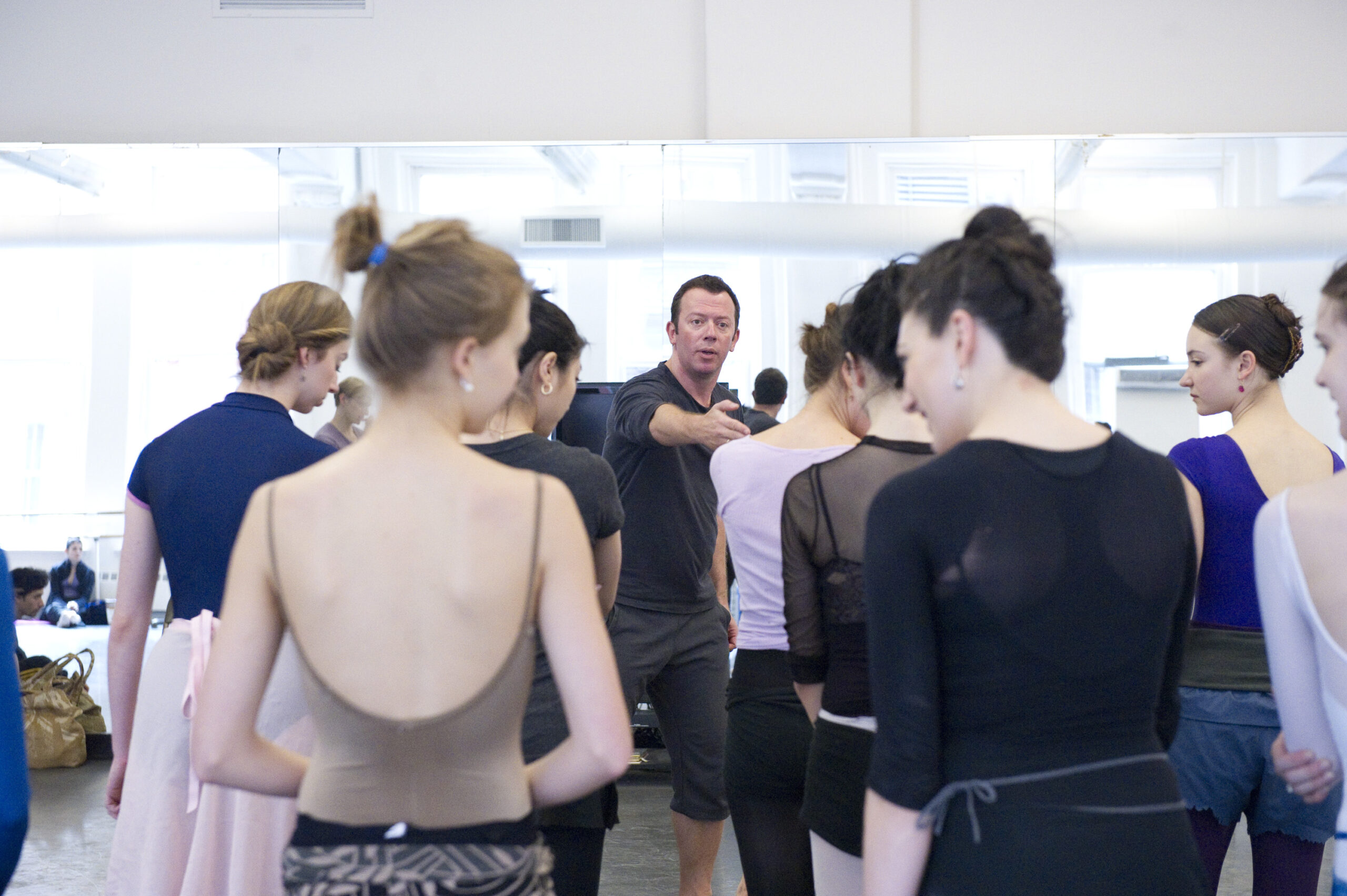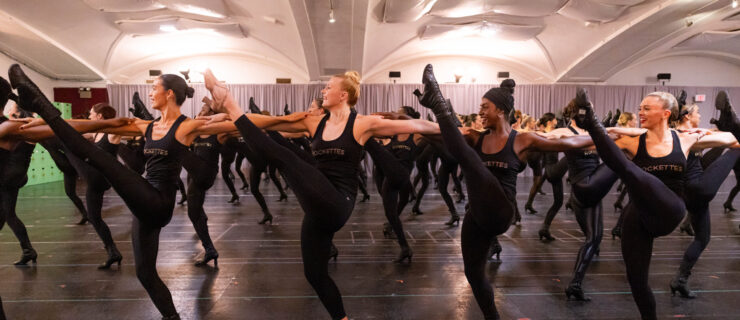Between Two Worlds (expanded version)
Choreographer Alexei Ratmansky brings a love of the old and a passion for the new to exploring ballet’s possibilities.
With commissions streaming in, Alexei Ratmansky often juggles projects with several ballet companies at once. His combination of movement invention, rich emotional tone, and whimsical humor has attracted artistic directors all over the world. He’s made more than 25 ballets for at least 10 companies including the New York City Ballet, American Ballet Theatre, Royal Danish Ballet, the Kirov, San Francisco
Ballet (the first company to bring him to the U.S.), State Ballet of Georgia, and of course, the Bolshoi—winning many prizes along the way.
Ratmansky studied at the Bolshoi Ballet School with famed teacher Pyotr Pestov (“Teacher’s Wisdom,” Oct. 2009). After graduating in 1986, he danced with Kiev Ballet, and was a principal at the Royal Winnipeg and Royal Danish Ballet. As artistic director of the Bolshoi Ballet from 2004 to 2008, he brought in a number of western choreographers. He also launched the careers of young Bolshoi superstars Natalia Osipova and Ivan Vasiliev.
Although he often restages old story ballets, he has made brilliant plotless ballets, like last season’s
Seven Sonatas for ABT. Whatever the genre, he is committed to exploration in the studio. “If a process feels risky to me,” he said in these pages in 2003, “it feels good.”
Ratmansky, 41, became artist in residence with ABT in January 2009 and has made three ballets for them. Next month his new ballet for NYCB premieres as part of its spring season’s explosion of new work. He lives in Manhattan with his wife Tatiana Kilivniuk, a former dancer with Kiev Ballet with whom he developed his early choreography, and their son Vasily.
Dance Magazine‘s Wendy Perron met with this modest and thoughtful dancemaker at ABT’s studios in January to discuss his work.
When did you start to choreograph?
I started in school in Moscow. I think even before that I had some kind of urge to organize kids around.
You’ve referred to your time as a student as “The Golden Era of the Bolshoi.” What was that like?
For us it was an incredible experience to see Maya [Plisetskaya], Vasiliev, and Maximova, Bessmertnova, Lavrovsky. The aura around them was so strong that I don’t think I could analyze what I saw. But I liked it because it was just overwhelming.
When you graduated you were not asked to join the Bolshoi. Were you disappointed?
Yes, I was. What helped me to overcome it is that the best graduate of the class, [Vladimir] Malakhov, was not accepted either.
When you returned to the Bolshoi as artistic director 18 years later, what did you want to accomplish?
My experience as a spectator during the late 90s, was so different from what I remembered from school. It was less intense, less inspiring. It was almost boring. Most of the productions were dating from 60s, 70s, 80s. I didn’t feel the dancers were involved in what they were doing. That’s what I wanted to change.
So you brought in Chris Wheeldon and other choreographers.
I thought that Bolshoi was for too long a theater of just one style, one choreographer, and the other Bolshoi features were lost, like what we can see in the film with Ulanova doing Giselle. I am now working with Het National Ballet in Amsterdam on Don Quixote, which is considered the only Gorsky creation that survived. No one can say what is basic qualities of Gorsky; it’s very possible that most of it is still Petipa. But that was a huge, long period of Bolshoi history. I thought that taking together all those important moments of the Bolshoi history, giving the dancers the feel of this tradition—not only the 30 years of Grigorovich’s reign—would somehow define this style.
When you made
The Bright Stream , many people said that it refreshed the Bolshoi. Do you think it had a good impact?
For me it was a happy experience, first of all discovering this great music by Shostakovich. Because we all read about it in the history books, and the terrible misfortune [it was banned by Stalin]. And I had a great time with the dancers. What critics wrote about it is that it somehow gave a sense of another Bolshoi history, which was probably important at that moment.
But the critics also wrote that it was funny and delightful too.
It’s a comedy; this is something that was gone from the Bolshoi’s repertoire—even though the Bolshoi rep was always considered more democratic than the Kirov, less sophisticated, more direct contact with the audience, doing it for the audience. So the authorities thought that this was the right thing for the Bolshoi. Just preserving the Grigorovich works would not lead anywhere.
During your five years as director of the Bolshoi, do you feel you moved the company forward?
Well, one performance goes well, the next one you feel like nothing works. In general the idea what is the Bolshoi, even among the most conservative dancers and audiences, has changed a little bit. They saw that there is no harm to invite Westerners and do neo-classics, and even—omigod—some contemporary! It definitely brought up a new generation of dancers.
Do you approach choreographing differently whether you’re making a piece for Russian dancers or for Western dancers?
Maybe it’s not that conscious, but I think it comes from knowing or sensing what are the dancers’ strengths and weaknesses. Or in the case of the Bolshoi, trying to give them the challenge of something that they can learn from. At the Bolshoi I was never just a choreographer; my director part was always present.
Tell me about Nina Ananiashvili and the role she played in your career
.
She gave me the first real commission. I had done a full evening at Kiev Ballet, but that happened because I danced there. Nina was the first one from outside. At some point, at a gala, I realized that she was the only interesting and really talented ballerina there. So when she asked me to do this for her I was extremely happy. It was a success, then a second ballet I did for her, and a third ballet. I was very grateful to her.
When did you first become aware of Balanchine’s work?
I think I saw Apollo on a video. Pyotr Pestov [“Teacher’s Wisdom,” Oct. 2009] showed us after we graduated. Then in Kiev there was a great dancer called Arkady Koftom and he also was a devotee of Balanchine; he showed us some videos. Then Monte Carlo Ballet brought The Prodigal Son and Stravinsky Violin Concerto to Moscow. The connection with the music was amazing, so he was a huge influence.
Your pieces are very different depending on the music. How do you choose your music?
When I was in school I made a long list of the music that I want to use, and I’m still working with that list.
When you start doing a ballet, do you know right away whether it’s going to be a story ballet?
If I take music that has no story, I will do a more abstract piece. But it’s never abstract; I would always try to squeeze something into it. In the new production of The Corsaire that we did at the Bolshoi, I had to choreograph some divertissemens, which were purely dancing. But in the symphonic music I always hear some kind of—it’s not a story—some colors, nuances, details, or relationships or whatever.
In February 2008, it was announced that New York City Ballet offered you a position as choreographer in residence. Why did that not happen?
I thought everybody got over it already. Everything went well until I mentioned that I have this commission and that commission, and Peter [Martins] just thought that as a residence choreographer I’ve got to spend more time. And that’s true. The ABT season is much less, and Kevin has nothing against me going to different places.
It’s very personal when you start choreographing with the dancers. It has to be some mutual sympathy and human experience. That’s what I treasure the most: trying to establish the relationship with the dancers. Because the dancers are so different in all the companies, even though it’s very globalized now and many companies are doing the same repertoire. But there are still very distinguishing features of, say, Australian dancers or Russian dancers, between Kirov and Bolshoi, between ABT and City Ballet.
Joaquin de Luz, Gonzalo Garcia, and Ashley Bouder of NYCB in Concerto DSCH. Photo by Paul Kolnik, Courtesy NYCB.
What are the differences between City Ballet and ABT dancers?
[At City Ballet there are] the ideas of Balanchine: the less presentation, the better, and the more honest with the steps you are, the better. And there’s such a huge repertoire of Balanchine and others. The dancers are very fast, very sophisticated in their movements. ABT is strong because of its combination of star dancers from different places, and it’s more theatrical. And they’re very experienced in classics and with diverse choreographers as Tharp and Tudor. And Baryshnikov’s time was very important in terms of how the style changed. So all that heritage is here with ABT.
Dancers have told me that they love working with you
.
That’s great to hear, but I feel equal with them. That maybe was part of the reason it was not so easy at the Bolshoi. The Bolshoi was such an exceptional place. They were so privileged. They were—and even if they weren’t—they considered themselves the gods.
Yes, even though they could have trouble with government, like Plisetskaya.
Her story was special. Plisetskaya was the one who I adored watching onstage. The way she danced the music, the way she nailed every note, every dynamic of the music, the way she moved her back and her arms made a huge impression on me. She was the center of everything wherever she was onstage. Also the lines, the neck and the chin, they were something out of the world. Her musicality is an example for me always. There are a lot of very musical dancers here in New York, especially in City Ballet. But she was not only dancing rhythm, she was dancing the orchestra sounds.
What is the music you’re using for the new piece at City Ballet
?
It’s one of the greatest scores, French music, a ballet score called Namouna, composed by Edouard Lalo. Serge Lifar used parts of it for his Suite en blanc (1943). Actually this ballet had a story, but I thought it was too similar to Corsaire. A man who’s in search of this certain Namouna, and she comes to him in different forms, sometimes she’s a gypsy, sometimes [with] a cigarette. It’s quite abstract, but still a story. I wanted to do a classical ballet in the old sense, with visible mime and character dancing, and solos and ensemble to make it a grand-divertissement. It is character dancing, but we don’t really know which character, which nation. It’s a story ballet, but abstract in a way.
Does one woman play all these different parts?
No, different women. I have Wendy Whelan, Jenifer Ringer, Sara Mearns, Megan Fairchild, Abi Stafford. Also Daniel Ulbricht and Robert Fairchild. I had great fun doing it.
And what about the Nutcracker for ABT in December? Will it be a Russian
Nutcracker or an American Nutcracker?
It probably will be somewhere in between, like I am—hanging between the traditions and styles and expectations. Nutcracker is challenging because everyone knows what they want to see. And everything has been done already. If the tree does not grow, people will be upset. My main concern is to listen to the music because the score is so great. It’s the reason the Nutcracker exists. You can’t jump over Tchaikovsky. And every day you listen differently. You’re a different person and the life around you is different. Even though I’ve made a Nutcracker for Royal Danish in 2001, and I started one at the Kirov.
Will you use what you did before or work with a clean slate?
I don’t think you can ever clean everything out of your head. But I will try to make new steps.
So, what part of you is Russian and what part of you is American?
My school, the base, is Russian. I thought I was always thinking of the best possible base—at least that’s what we were taught. And then coming to Canada and Denmark I thought that by using what I learned there, I can make the school better. We Russians shouldn’t be afraid of absorbing, of mixing. The Russian school is a combination of different traditions: French, Danish, an Swedish. I can’t go back to phrasings so dull as sometimes the Russians’ are, or the transitions so messy, or contact with the audience so obvious, or bows taking such a long time. Also, if you look at Balanchine, or Massine, or Nijinsky, they are Russians but what they’ve done, they did in the West. If they stayed in Russia, they wouldn’t be themselves, or what we know of them. So how do we take this tradition: Is it Russian, or again, a mix?
And what part of your choreography is American?
I’ll only say that I adore the spirit in American students. The dedication of American dancers, their speed, their willingness to give 200 percent to what they do. It’s an American quality that I’m looking for everywhere now. It’s hard to find.
Do you talk about that journey from Russia with Baryshnikov?
We haven’t talked about it yet. I always wanted to ask him some of that question, how his schooling has transformed. What really interests me is, Where is the Russian school now, how it could be reshaped, what are the positive and negative sides now? But I was lucky enough to get to know him, and to have the chance to choreograph for him.
What was it like to make a solo for him?
He was not feeling well so he marked a lot of things. But when I saw what he has done with what I gave him, that was really amazing—his ability to shape everything in an amazing way! We all know that. He is the most intellectual classical dancer I’ve ever seen.
Xiomara Reyes and Herman Cornejo in the scintillating Seven Sonatas for ABT, photo by Rosalie O’Connor, Courtesy ABT.
What do you do in between choreographing to gear yourself up for the next project?
Looking around, reading. Listen to the music. Just letting your head be empty and light helps. I feel that I need to challenge myself. I have a fear that maybe it’s not gonna last long or something. I wanna use every chance because it gives me the feeling that I develop, that I go somewhere. Another reason for leaving the Bolshoi was that I needed time to choreograph. The administration work was so huge that it took all my time. So now when I’m not at the Bolshoi I think I should do much more!
What do you look for in dancers?
An individual quality of movement, which is rare, very rare. It depends on the physique and the proportions. Musicality is equally important. It’s hard for me to work with dancers who aren’t rhythmical or who can’t hear the dynamics of the phrase and play with it. Also the involvement, the attack, the willingness to make the movement flow, to explore every movement. You can never be perfect. Every movement could be done in a hundred different ways. The ability for not being happy with what they’ve done the first time.
When you look back on your work, do you have a favorite piece?
I have good feelings about the pieces that were the most challenging for me to make. Pierrot Lunaire, On the Dnieper. Seven Sonatas was also very difficult to make, for some reason.
Why was
Pierrot Lunaire difficult to make?
Because the music, the Schoenberg, is not good for dancing.
So why did you choose it?
Because I liked it. I wanted to hear it more and more and to be involved with it. I also wanted to challenge Diana [Vishneva]. It was interesting because she was like, “No no no—anything, but not that music!” I said, “Trust me, you gonna love this music.” And she did.
Do you have any advice for a young dancer who wants to be a choreographer?
If he wants, he will be. In Russia, it’s much more difficult for dancers to become a choreographer. It’s such a past-oriented ballet culture. Dancers at ABT or NYCB are so ready to be taken anywhere by the choreographer. While the Russians are—with exceptions like Diana, and a few others—preoccupied with how they think they should look or what their friends think. The main theaters are so afraid of doing new stuff, because they’ve been beat up by not 100 percent satisfying new productions. They play safe. Luckily I already established myself as a choreographer. But for someone who wants to be a choreographer, it’s almost impossible to break through the wall. That situation has to change.
Want to learn more about Alexei Ratmansky? Got to dancemedia.com for videos of our
cover shoot
and interview.




